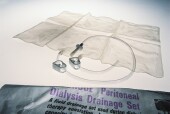
THURSDAY, Feb. 21 (HealthDay News) — Dialysis patients using catheters have a higher risk for death, infection and heart problems than patients using other procedures to access the blood, according to a new analysis.
Researchers examined 67 studies involving nearly 600,000 dialysis patients to compare the risks associated with three procedures used to access the blood: arteriovenous fistula, arteriovenous graft and central venous catheter.
An arteriovenous fistula is formed when a patient’s vein and artery are connected to form a site through which blood can be removed and returned. An arteriovenous graft is a plastic channel between an artery and a vein. A third option for dialysis patients is a catheter, which patients often use to avoid surgery or needles or because of declining health.
Because of kidney failure, more than 1.5 million people around the world are treated with hemodialysis. The procedure involves filtering the blood to remove wastes, extra salt and water.
In conducting the study, the researchers assessed the link between these three types of vascular access and death, infection and major heart problems, such as heart attack and stroke.
The study, published Feb. 21 in the Journal of the American Society of Nephrology , revealed that patients using catheters had a 38 percent greater risk for a major heart problem, a 53 percent higher risk of dying and more than double the risk of developing a fatal infection than patients with fistulas.
Grafts also had an 18 percent higher risk of death and a 36 percent greater risk of serious infections than fistulas. But the researchers noted that patients with grafts did not have a greater risk for a major heart problem than those with fistulas.
Assuming patients on dialysis were of similar health, the researchers concluded that catheters used for hemodialysis have the highest risks for death, infections and heart trouble, while fistulas are the least risky.
“Our findings are reflected in current clinical practice guidelines, which promote fistulas as the preferred form of bloodstream access in hemodialysis patients,” Dr. Pietro Ravani, of the University of Calgary, in Canada, said in a journal news release.
The study’s authors noted that patients involved in the study who were using catheters were probably sicker than those using fistulas. They concluded that more research is needed to determine individual patient risk and assess the safety of the various types of blood access used for hemodialysis.
More information
The U.S. National Kidney and Urologic Diseases Information Clearninghouse provides more information on hemodialysis.

